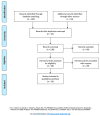Oncological Outcomes of Primary vs. Salvage OPHL Type II: A Systematic Review
- PMID: 35162858
- PMCID: PMC8835477
- DOI: 10.3390/ijerph19031837
Oncological Outcomes of Primary vs. Salvage OPHL Type II: A Systematic Review
Abstract
Background: Open partial horizontal laryngectomy type II (OPHL type II) has two main aims: oncological radicality and laryngeal preservation. The aim of this review is to define and emphasize the oncological efficacy of OPHL type II, both as primary and salvage surgery, by analyzing the latest literature. Methods: The research was carried out on Pubmed, Scopus and Web of Science databases, by using strict keywords. Oncological outcomes were evaluated by the following parameters: overall survival, disease-specific survival, disease-free survival, local control, laryngeal preservation, local recurrence. Results: The review included 19 articles divided into three groups: (1) primary OPHL type II, (2) salvage OPHL type II, (3) adjuvant radiotherapy after primary OPHL type II. The articles showed excellent results as far as oncological radicality and organ preservation. Conclusions: This review demonstrated that OPHL type II is useful to obtain oncological radicality both as primary surgery and salvage surgery. Nevertheless, the only criterion that determined the positive outcome and efficacy of this technique is the strict selection of patient and tumor.
Keywords: head and neck; laryngectomy; otolaryngology; salvage therapy; surgical oncology.
Conflict of interest statement
The authors declare no conflict of interest.
Figures
Similar articles
-
Open Partial Horizontal Laryngectomy as a Conservative Salvage Treatment for Laser-Recurrent Laryngeal Cancer: A Multi-Institutional Series.Curr Oncol. 2024 Dec 27;32(1):12. doi: 10.3390/curroncol32010012. Curr Oncol. 2024. PMID: 39851928 Free PMC article.
-
Prognostic significance of surgical margins in open neck horizontal laryngectomy: a systematic review and meta-analysis.Acta Otorhinolaryngol Ital. 2025 May;45(Suppl. 1):S87-S98. doi: 10.14639/0392-100X-suppl.1-45-2025-N992. Acta Otorhinolaryngol Ital. 2025. PMID: 40400379 Free PMC article.
-
Selected laryngeal squamous cell carcinomas with laryngeal mobility impairment are suitable for curative larynx-preservation treatment: A multi-institutional study on 406 patients from the ARYFIX collaborative group.Oral Oncol. 2025 Aug;167:107466. doi: 10.1016/j.oraloncology.2025.107466. Epub 2025 Jul 7. Oral Oncol. 2025. PMID: 40627950
-
Outcomes of Supracricoid Partial Laryngectomy Performed in the United States: A Systematic Review.Laryngoscope. 2024 Jul;134(7):3003-3011. doi: 10.1002/lary.31273. Epub 2024 Jan 22. Laryngoscope. 2024. PMID: 38251796
-
Open partial horizontal laryngectomy for salvage after failure of CO₂ laser-assisted surgery for glottic carcinoma.Eur Arch Otorhinolaryngol. 2016 Jan;273(1):169-75. doi: 10.1007/s00405-015-3734-2. Epub 2015 Aug 21. Eur Arch Otorhinolaryngol. 2016. PMID: 26294221
Cited by
-
Rehabilitation after supracricoid partial laryngectomy: cohort study.Braz J Otorhinolaryngol. 2025 Mar-Apr;91(2):101532. doi: 10.1016/j.bjorl.2024.101532. Epub 2024 Nov 19. Braz J Otorhinolaryngol. 2025. PMID: 39566295 Free PMC article.
-
Open Partial Horizontal Laryngectomy as a Conservative Salvage Treatment for Laser-Recurrent Laryngeal Cancer: A Multi-Institutional Series.Curr Oncol. 2024 Dec 27;32(1):12. doi: 10.3390/curroncol32010012. Curr Oncol. 2024. PMID: 39851928 Free PMC article.
-
Swallowing Outcomes in Open Partial Horizontal Laryngectomy Type I and Endoscopic Supraglottic Laryngectomy: A Comparative Study.Int J Environ Res Public Health. 2022 Jun 30;19(13):8050. doi: 10.3390/ijerph19138050. Int J Environ Res Public Health. 2022. PMID: 35805718 Free PMC article.
References
-
- Majer E.H., Rieder W. Technic of laryngectomy permitting the conservation of respiratory permeability (cricohyoidopexy) Les Ann. D’oto-Laryngol. 1959;76:677–681. - PubMed
-
- Piquet J.J., Desaulty A., Decroix G. La crico-hyoïdo-épiglotto-pexie. Technique opératoire et résultats fonctionnels. Ann. Otolaryngol. Chir. Cervicofac. 1974;91:681–686. - PubMed
-
- Forastiere A.A., Ismaila N., Lewin J., Nathan C.A., Adelstein D.J., Eisbruch A., Fass G., Fisher S.G., Laurie S.A., Le Q.-T., et al. Use of Larynx-Preservation Strategies in the Treatment of Laryngeal Cancer: American Society of Clinical Oncology Clinical Practice Guideline Update. J. Clin. Oncol. 2018;36:1143–1169. doi: 10.1200/JCO.2017.75.7385. - DOI - PubMed
Publication types
MeSH terms
LinkOut - more resources
Full Text Sources


